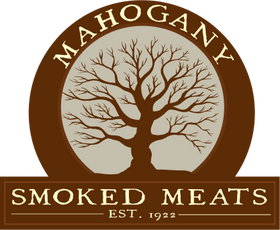From holiday meals to family feasts, ham is a staple for feeding a large group of people and leaving everyone satisfied. Beyond simply enjoying it plain as the main entree, there are countless ways to make use of leftovers, from soups to sandwiches.
But there are many different types of ham to choose from, which is where people get overwhelmed in trying to plan the perfect meal. We’re not just talking about bone-in vs boneless ham. You also need to pick between black forest ham vs smoked ham
So what’s the difference between black forest ham and smoked ham? Is black forest ham smoked? We’ll answer all your questions about smoked ham vs black forest ham here in this guide, leaving you with complete clarity as to which style is right for you.
Black forest ham can technically be a type of smoked ham. The key distinction is it tends to be cold-smoked rather than hot-smoked, which merely adds flavor without cooking the meat to a safe internal temperature. You then need to prepare it at home yourself.
In contrast, a fully smoked ham saves time and stress since it’s already fully cooked - you just have to warm it to enjoy it. This is the approach we take here at Mahogany Smoked Meats, and it’s part of what keeps customers coming back for more.
But don’t just take our word for it - try our smoked bone-in ham for sale or smoked boneless ham for sale today and discover the difference a century of tradition makes!
What’s the Difference Between Black Forest Ham and Smoked Ham?
You might think ham is ham and you’re more or less getting the same thing at the end of the day, but that couldn’t be further from the truth. The difference between black forest ham and smoked ham is jarring: taste, texture, nutrition, culinary uses, and more.
Each has its place, but only one is right for a given occasion. So let’s take a look at the key characteristics of each below before comparing and contrasting black forest ham vs smoked ham.
The Basics of Black Forest Ham
Black Forest ham, or Schwarzwälder Schinken, is rich in history. It originates from Germany’s Black Forest region as the name suggests, and is known for its bold, smoky flavor and deep, dark exterior.
The ham is dry cured with a seasoning blend of salt, garlic, coriander, pepper, and juniper berries before being left to age. What makes it so unique is its cold-smoking process, where the ham is smoked at low temperatures over pine or fir wood for several weeks. This leads to:
- A drier texture due to the moisture loss during curing.
- An intense smoky flavor that stands out in sandwiches, charcuterie boards, and European-style dishes.
- A darker, almost black crust, a signature of traditional Black Forest ham.
Black forest ham is among the most versatile options at your fingertips. It can be served cold and thinly sliced, paired with delicatessens and gourmet charcuterie platters. Or, it can be the centerpiece of a meal. The possibilities are endless.
What is a Smoked Ham?
True smoked ham is more widely recognized, at least here in North America. It’s known for its juicier texture and milder smoky flavor. While most people are talking about hot-smoked ham when they use the term “smoked ham,” it can technically be cold-smoked as well:
- Hot-Smoked Ham: Cooked at higher temperatures (between 140°F and 200°F) so it’s fully cooked and ready to eat. Just warm and enjoy!
- Cold-Smoked Ham: Smoked at lower temperatures (below 90°F) for flavor but further cooking is necessary before consumption not just for taste/texture, but food safety.
So is a smoked ham fully cooked? Being able to differentiate between cold and hot smoked ham is essential. Look for terms like “fully cooked,” or “ready to enjoy.”
The type of wood used to smoke the ham (hickory, applewood, mahogany, etc.) has a direct impact on the level of smokiness infused into the ham, ranging from lightly infused to deeply rich.
Smoked ham is often glazed, slow-cooked, or roasted as well. Along with smoked turkey, it’s a popular centerpiece for holidays and family gatherings. But truthfully, there’s never a bad time to enjoy it!
Is Black Forest Ham Smoked?
So is black forest ham smoked? This is a common question we get asked here at Mahogany Smoked Meats, and we want to clear it up once and for all before moving on to our comparison of black forest ham vs smoked ham.
The short answer is yes, but how it’s smoked is unique. Traditional Black Forest ham is cold-smoked over fir or pine wood for weeks to yield a more concentrated, deeper smoky taste than other varieties.
You may think, well if it’s cold-smoked it’s not safe to eat right away, it needs to be prepared further. That’s not necessarily the case. Remember, it’s cured beforehand to ensure it's safe to eat. That being said, let’s take a closer look at how smoked ham vs black forest ham stack up.
Black Forest Ham vs Smoked Ham: Which Flavor is Right For You?
You should have a fairly solid grasp on the difference between black forest ham and smoked ham at this point, but are you still wondering which is right for you? We’ll compare and contrast smoked ham vs black forest ham below to leave you with complete clarity and certainty.
Different Smoking Methods
Ultimately the differences in smoking methods between black forest ham vs smoked ham lead to differences in taste, texture, culinary uses, and even nutrition. This comes down to 3 distinctions:
- The type of wood used for the smoking process.
- The temperature used for the smoking process.
- How long the meat is smoked for.
Black Forest ham is cold-smoked at low temperatures over pine or fir wood for a long period of time. This results in intensely smoky, concentrated flavor with a dry, firm texture.
In contrast, traditional smoked ham is hot-smoked at higher temperatures for shorter periods (although it’s still a “slow” smoking process in the grand scheme of things).
The type of wood used ranges from mahogany to hickory and many others. The flavor is juicer, milder, and more versatile. Speaking of flavor…
The Taste Test
What matters most in choosing between smoked ham vs black forest ham is taste, so it’s really as simple as considering which flavor profile you prefer.
Are you craving strong, deep smoky flavor that compares to barrel-aged foods, with a slightly nutty or woody undertone? You can’t beat the intensity that black forest ham brings to the table.
On the other hand, you might be looking for something more subtle, with a more nuanced flavor profile. Traditional smoked ham has a complex, naturally sweet taste influenced by the type of wood used. In general, this variety is less overpowering than black forest ham.
Texture and Moisture Content
You’ll notice another massive difference between black forest ham and smoked ham - texture. This is because of the unique smoking methods used for each.
Because it’s first cured and then cold-smoked for a really long time, black forest ham ends up being much drier and firmer than traditional smoked ham.
It has been more closely compared to prosciutto or other dry-cured meats than other types of smoked ham. In this sense, it’s perfect for serving cold as part of a bigger charcuterie - more on that later.
Meanwhile, traditional smoked ham retains much more moisture since it’s hot-smoked for a shorter duration of time. The bite is famously juicy and tender, especially when paired with the right glaze and served warm.
Nutritional Differences
While both hams are high in protein and rich in flavor, there are some subtle differences in nutrition as a result of preparation methods. It really comes down to moisture content.
Since black forest ham is lower in moisture it might have slightly less fat and a more concentrated nutrient profile per serving. Just be aware that the curing process can introduce quite a bit of extra sodium.
Smoked ham, on the other hand, holds more water weight which lowers the sodium concentration per bite but doesn’t necessarily reduce total sodium intake. You still need to practice portion control if you’re monitoring sodium.
Culinary Uses and Pairings
Choosing between black forest ham vs smoked ham can be as simple as comparing their common culinary uses. While there is some overlap in how they can be enjoyed, they ultimately serve different purposes. Black forest ham is great for:
- Cold deli sandwiches (pairs well with rye bread, mustard, and Swiss cheese).
- Charcuterie boards (complements cheeses, nuts, and fruits).
- Egg-based dishes like quiche or omelets.
But when most people think ham, they envision a holiday spread with this entree as the centerpiece. Black forest ham would not be a good choice here, but traditional smoked ham would be perfect. Traditional smoked ham is also great for:
- Classic breakfast plates (pairs well with eggs, hash browns, and biscuits).
- Savory dishes like soups, stews, and casseroles.
- Sandwiches in the following days using leftovers.
Don’t overcomplicate the choice between smoked ham vs black forest ham!
Which One is Right for You?
There’s no one-size-fits-all answer, just like with the question - is bone-in ham better than boneless? It’s a matter of personal preference and the intended usage.
You could technically enjoy both at the same time, using black forest ham as part of an appetizer spread while indulging in traditional smoked ham for the main course.
But if you do decide to go with traditional smoked ham, you’re in for a real treat. We’ve taken all the hard work and stress out of preparing your next dinner at Mahogany Smoked Meats.
Taste the Difference a Century of Tradition Makes at Mahogany Smoked Meats!
Mahogany Smoked Meats has spent over a century perfecting the art of premium smoked meats, combining time-honored techniques with the finest ingredients to create rich, flavorful hams unlike anything else you’ve tried before.
Our authentic hardwood smoking process in deep pits using fallen mahogany logs creates meats that are deeply savory, tender, and infused with just the right amount of smokiness - a difference you can taste in every bite.
Whether you prefer the classic, rich flavor of bone-in smoked ham or the convenience of boneless ham without sacrificing quality, we offer both options expertly smoked to perfection.
Oh, and you don’t have to worry about how to cook a smoked ham with the bone still in or how to cook a boneless ham when you let us handle it for you. Just take some time to learn how to carve a bone-in ham, warm the ham per the instructions on the packaging, and enjoy!
This leaves you more time to prepare sides for the spread, or simply kick back and relax while you catch up with loved ones. You can find so many other great meats in our catalog too, ranging from smoked ham steaks for sale to smoked sausages for sale.
Closing Thoughts on Smoked Ham vs Black Forest Ham
That does it for our detailed comparison of black forest ham vs smoked ham. We hope you understand the difference between black forest ham and smoked ham and have a solid idea of which is right for you at this point.
Both have their place, but they serve different purposes. Black Forest ham delivers a bold, deeply seasoned flavor with a signature dark crust, while smoked ham provides a classic, rich smokiness with a juicy, tender bite.
Whether you’re looking for a savory addition to a charcuterie board or a show-stopping centerpiece for a meal, it’s really just a matter of personal preference.
Our blog has additional resources on topics like how many pounds of ham per person you need to order or how long is ham good in the fridge after cooking it.
But at this point, the only thing left to do is spoil yourself and your loved ones at Mahogany Smoked Meats. Bring home the finest smoked ham today and taste the difference in every bite!





